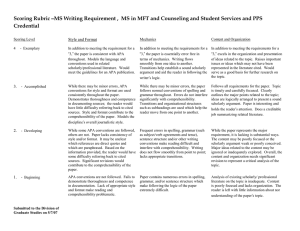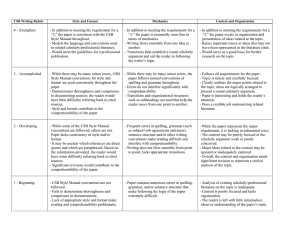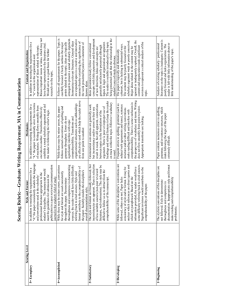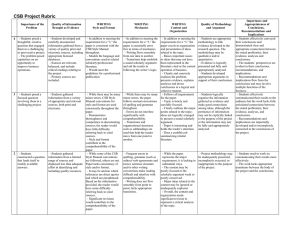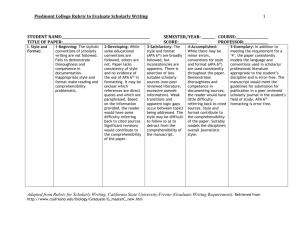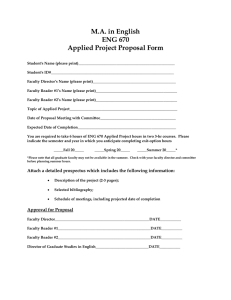1. The writing requirement must be completed before the... for Advancement to Candidacy or participates in an internship. The... To satisfy the Graduate Writing Requirement
advertisement
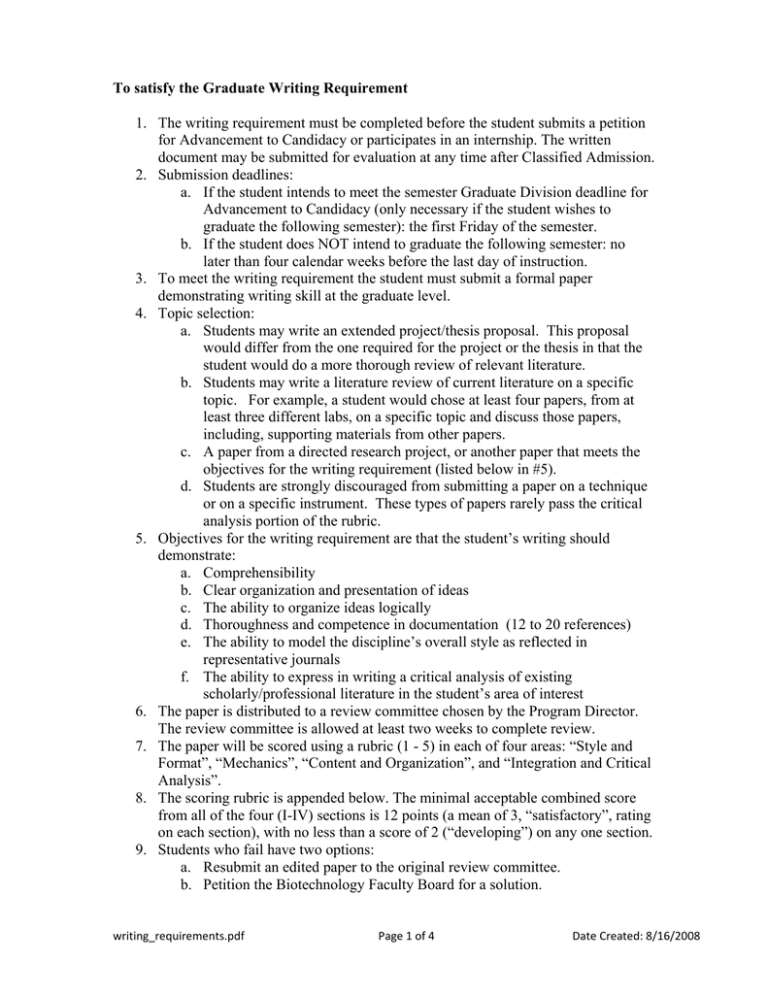
To satisfy the Graduate Writing Requirement 1. The writing requirement must be completed before the student submits a petition for Advancement to Candidacy or participates in an internship. The written document may be submitted for evaluation at any time after Classified Admission. 2. Submission deadlines: a. If the student intends to meet the semester Graduate Division deadline for Advancement to Candidacy (only necessary if the student wishes to graduate the following semester): the first Friday of the semester. b. If the student does NOT intend to graduate the following semester: no later than four calendar weeks before the last day of instruction. 3. To meet the writing requirement the student must submit a formal paper demonstrating writing skill at the graduate level. 4. Topic selection: a. Students may write an extended project/thesis proposal. This proposal would differ from the one required for the project or the thesis in that the student would do a more thorough review of relevant literature. b. Students may write a literature review of current literature on a specific topic. For example, a student would chose at least four papers, from at least three different labs, on a specific topic and discuss those papers, including, supporting materials from other papers. c. A paper from a directed research project, or another paper that meets the objectives for the writing requirement (listed below in #5). d. Students are strongly discouraged from submitting a paper on a technique or on a specific instrument. These types of papers rarely pass the critical analysis portion of the rubric. 5. Objectives for the writing requirement are that the student’s writing should demonstrate: a. Comprehensibility b. Clear organization and presentation of ideas c. The ability to organize ideas logically d. Thoroughness and competence in documentation (12 to 20 references) e. The ability to model the discipline’s overall style as reflected in representative journals f. The ability to express in writing a critical analysis of existing scholarly/professional literature in the student’s area of interest 6. The paper is distributed to a review committee chosen by the Program Director. The review committee is allowed at least two weeks to complete review. 7. The paper will be scored using a rubric (1 - 5) in each of four areas: “Style and Format”, “Mechanics”, “Content and Organization”, and “Integration and Critical Analysis”. 8. The scoring rubric is appended below. The minimal acceptable combined score from all of the four (I-IV) sections is 12 points (a mean of 3, “satisfactory”, rating on each section), with no less than a score of 2 (“developing”) on any one section. 9. Students who fail have two options: a. Resubmit an edited paper to the original review committee. b. Petition the Biotechnology Faculty Board for a solution. writing_requirements.pdf Page 1 of 4 Date Created: 8/16/2008 Scoring rubric used to evaluate student submissions to satisfy the Graduate Writing Requirement. I. Style and Format: 5-Exemplary: In addition to meeting the requirement for a "4," the paper consistently models the language and conventions used in the scholarly/ professional literature appropriate to the student’s discipline. The manuscript would meet the guidelines for submission for publication in a peer reviewed biological journal in the student's field of study. 4-Accomplished: While there may be minor errors, conventions for style and format are used consistently throughout the paper. Demonstrates thoroughness and competence in documenting sources; the reader would have little difficulty referring back to cited sources. Style and format contribute to the comprehensibility of the paper. Suitably models the discipline's overall journalistic style. 3-Satistfactory: The style and format are broadly followed, but inconsistencies are apparent. There is selection of less suitable scientific sources (non-peer reviewed literature, web information). Weak transitions and apparent logic gaps occur between topics being addressed. The style may be difficult to follow so as to detract from the comprehensibility of the manuscript. 2-Developing: While some biological conventions are followed, others are not. Paper lacks consistency of style and/or format. It may be unclear which references are direct quotes and which are paraphrased. Based on the information provided, the reader would have some difficulty referring back to cited sources. Significant revisions would contribute to the comprehensibility of the paper. 1-Beginning: The stylistic conventions of scientific writing are not followed. Fails to demonstrate thoroughness and competence in documentation. Inappropriate style and format make reading and comprehensibility problematic. II. Mechanics: 5-Exemplary: In addition to meeting the requirements for a "4," the paper is essentially error free in terms of mechanics. Writing flows smoothly from one idea to another. Transitions effectively establish a sound scholarly argument and aid the reader in following the writer's logic. 4-Accomplished: While there may be minor errors, the paper follows normal conventions of spelling and grammar throughout. Errors do not significantly interfere with topic comprehensibility. Transitions and organizational structures such as subheadings are effectively used which help the reader move from one point to another. 3-Satisfactory: Grammatical conventions are generally used, but inconsistency and/or errors in their use result in weak, but still apparent, connections between topics in the writing_requirements.pdf Page 2 of 4 Date Created: 8/16/2008 formulation of the argument. There is poor or improper use of headings and related features to keep the reader on track within the topic. Effective scientific vocabulary is used. 2-Developing: Frequent errors in spelling, grammar (such as subject/verb agreements and tense), sentence structure and/or other writing conventions make reading difficult and interfere with comprehensibility. There is some confusion in the proper use of scientific terms. Writing does not flow smoothly from point to point; appropriate transitions are lacking. 1-Beginning: Paper contains numerous errors in spelling, grammar, and/or sentence structure, which make following the logic of the paper extremely difficult. Scientific terms are misused. III. Content and Organization: 5-Exemplary: In addition to meeting the requirements for a "4," excels in the organization and representation of ideas related to the topic. Raises important issues or ideas, which may not have been represented in the literature cited. 4-Accomplished: Follows all requirements for the paper. Topic is carefully focused. Clearly outlines the major points related to the topic; ideas are logically arranged to present a sound scholarly argument. Paper is interesting and holds the reader's attention. General ideas are expanded upon in a logical manner. 3-Satisfactory: Ideas presented closely follow conventional concepts with little expansion and development of new directions. Certain logical connections or inclusion of specific topics related to the student’s area of study may be omitted. Ideas and concepts are generally satisfactorily presented although lapses in logic and organization are apparent. The reader is suitably introduced to the topic being presented such that the relationship to the student’s area of study is obvious. 2-Developing: The paper is logically and thematically coherent, but is lacking in substantial ways. The content may be poorly focused or the scholarly argument weak or poorly conceived. Major ideas related to the content may be ignored or inadequately explored. 1-Beginning: Analysis of existing scholarly / professional literature on the topic is inadequate. Content is poorly focused and lacks organization. The reader is left with little information about or little understanding of the paper's topic. IV. Integration and Critical Analysis: 5-Exemplary: The document presents the current state of knowledge for the topic being addressed utilizing a diversity of scientific opinions. These various, and possibly conflicting, opinions are presented in a balanced manner and seamlessly woven together to illustrate a complete grasp of the scientific literature across multiple research writing_requirements.pdf Page 3 of 4 Date Created: 8/16/2008 approaches utilizing appropriate national and international peer-reviewed journals. Essential findings of multiple sources are accurately and concisely paraphrased, analyzed, and integrated. Original sources are clearly identified and correctly cited in both the body of the text and the reference section. Organizationally, smooth and effective transitions between topics lead the reader through an orderly discussion of the topic being addressed. The gaps in current knowledge are clearly identified and significant directions. 4-Accomplished: There are inconsistencies in the organization and logic of the presentation, but still clear analysis of the presented materials. While synthesis of all aspects of the topic may show varying degrees of development, the overall consistency, thoroughness, and analysis result in a well-crafted document. 3-Satisfactory: Identification of key topics or uncertainties in the field may be incomplete. New concepts resulting from a synthetic presentation of ideas is poorly developed or lacking. Complex topics and related concepts are awkwardly presented and linkages among topics may be unclear. 2-Developing: Weakness is evident in the coverage of the field and analysis resulting in incorrect or poorly developed synthesis of results. Analysis is limited to categorizing and summarizing scientific topics. The resulting manuscript significantly degrades the comprehensibility of the document and the identification of knowledge gaps. 1-Beginning: The manuscript contains numerous flaws in the essential components of a literature review. The manuscript lacks a successful synthesis of disparate works, and there is no logical flow to the presentation. These issues result in a manuscript with limited comprehensibility and utility in illustrating the author’s effective grasp of the material. writing_requirements.pdf Page 4 of 4 Date Created: 8/16/2008
